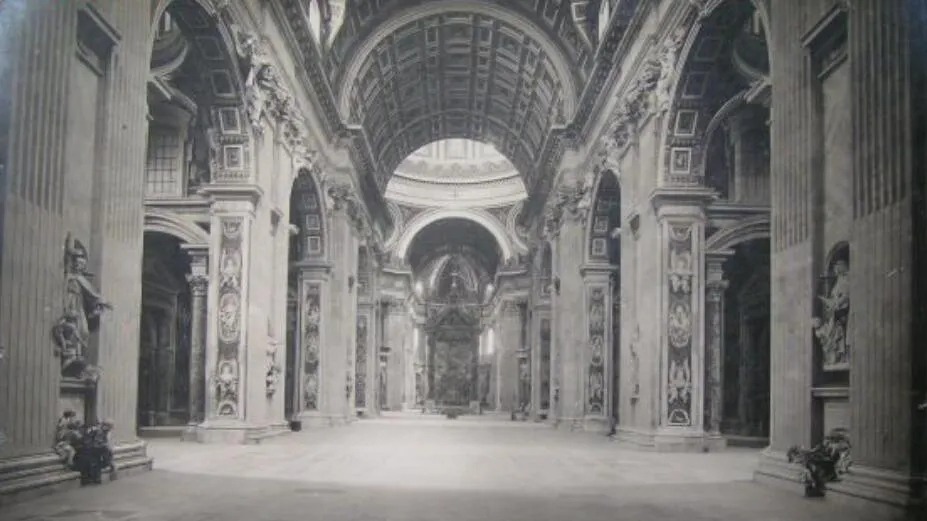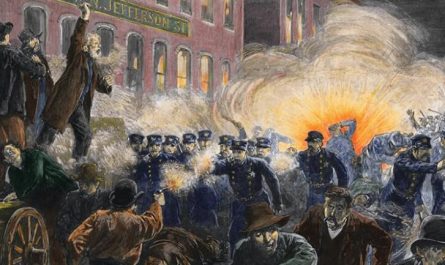As the smallest country in the world and a “country within a country”, the Vatican has a certain sense of existence. But when you open the map of Europe and see the “small dots” in a certain country like the Vatican and San Marino, do you wonder why they have not been annexed by the surrounding “big powers”? In fact, the Vatican was once annexed by Italy, but it was later “released”.
Above_ Interior view of St. Peter’s Basilica in Vatican
One. Why the Papal State was eaten by Italy
Regardless of how small the Vatican is today, its predecessor was the “Papal State” that was extremely prestigious in medieval Europe. The Papal State was established in the 8th century by the former Frankish Kingdom Palace Minister Peping dedicated the original Byzantine Governorate of Ravenna, where the newly conquered Italian Lombards were located, to the Catholic Pope living in Rome. The Frankish kingdom used secular power to make a deal with the religious power of the Holy See. From then on, the Pope of Rome has a thousand years of great authority and influence in Europe. Especially in the Middle Ages, the Pope controlled the coronation and appointment of the feudal monarchs of a large area of Western Europe, so that the monarchs of countries such as the Holy Roman Emperor had to succumb to himself (such as the “Insult of Canossa” incident).
Above_ Medieval Papal State
The authority of the Pope is rooted in the huge group of Catholic believers in Europe, and once this group starts to ignore the pope or even convert, then the authority of the pope no longer exists. Beginning in the 14th century, with the development of the capitalist economy and the outbreak of the European Black Death, the Renaissance and Reformation Movements began in Western Europe successively. People’s minds were gradually liberated, and a large number of believers converted to the newly established Lutheran and Gale Literary school or British Protestant, the authority of the pope began to waver.
Above_ The Papal State was annexed during Napoleon’s time
When the European Enlightenment broke out in the 18th century, Enlightenment thinkers such as Voltaire and Rousseau loudly called for the downfall of the evil force of the Holy See, further hitting the influence of the Pope. After the outbreak of the French Revolution, Napoleon I directly practiced this idea. First, he led the French army into Italy in 1798, captured the city of Rome, and captured the then Pope Pius VI back into exile in France. When he was crowned Emperor of the French Empire in 1804, Napoleon forced the new Pope Pius VII to rush from Rome to Paris for the coronation, but he took the crown directly from the Pope during the coronation ceremony and put it on his head. In 1808, Napoleon attacked Rome again, captured Pius VII also back to France, and directly annexed the land of the Papal State.
Above_ Coronation of Napoleon
Although Napoleon was finally defeated by the Anti-French Alliance and the Papal State was restored, his operation was to throw the faces of the Pope and the Holy See on the ground so that more Christians saw that the Pope was not holy . At that time, the northeastern part of Italy was controlled by Austria, the northwest was the Kingdom of Sardinia, the central part was the Papal State, and many small capitalist countries were established in the south, such as the two kingdoms of Sicily. Affected by the nationalism and liberalism of the French Revolution, all countries demanded the unification of the divided Italy as soon as possible. In 1848, the Roman citizens also launched an uprising, demanding the destruction of the theocracy of the unity of church and state, scaring the pope to escape from Rome in the disguise of ordinary priests, seeking the blessing of France, who is also a Catholic country.
Although the Holy See was humiliated enough by France during the Napoleon I period, after all, the Catholics in France accounted for the majority. In order to claim the emperor’s needs, Napoleon III, the ruler at the time, decided to pull the pope and sent troops to suppress the uprising of the Roman citizens. Garrison in Rome to defend the Pope. After the Kingdom of Sardinia undertook the mission of unifying Italy, but failed to defeat Austria, it allied with Prussia to fight the dynastic war and regained the northern territories occupied by Austria.
Later, in the Franco-Prussian War in 1870, the Kingdom of Italy, newly built by the Kingdom of Sardinia, took advantage of the opportunity when Napoleon III was defeated by Prussia, organized an army to attack Rome and moved its capital here, driving Pope Pius IX to the small town. Living in the Vatican was equivalent to being banned as a mascot, and the Papal State was completely annexed by Italy. However, the population of Catholics in Italy is huge. Many people only oppose the unity of state and church and do not oppose the pope himself. The voice calling for the dignity of the pope is very loud. Therefore, the Italian government has to reach a compromise with the pope and declare that the pope is inviolable and enjoys diplomacy. And financial privileges give a lot of funding. Pius IX insisted on confronting the Italian government, declared himself a “Vatican prisoner”, refused to recognize the demise of the Papal State, and bargained with the Italian government with the power of a large number of Catholic supporters.
This complicated relationship between Italy and the Vatican shows that the Vatican has the conditions to become a “state within a state.”
Above_ the map of Europe after the First World War
two. Mussolini needs the support of the Pope to establish a fascist regime
After the end of the First World War, Italy fell into a situation of economic crisis and social turmoil, which gave fascism the conditions to take root. Mussolini, the leader of the National Fascist Party, organized fascists and marched into Rome in 1922, making the then Italian King Vittorio Emanuele III appointed him as prime minister, and Italy became the world’s first fascist country. .
After Mussolini came to power, he politically enabled Fascists to control the Congress, control the army, promote anti-socialist, great power chauvinism and racist fascism, suppress democracy and the labor movement, and implement the “police state” system. Implement the wartime system economically, vigorously strengthen the construction of military industry and other light and heavy industries, and at the same time pay attention to infrastructure construction to improve the people’s living standards. Culturally, fascism is promoted in major national news media, newspapers and movie theaters, and learning and education reforms are promoted. The “Juvenile Pioneers” and the “Italian Littorio Youth League” are established to brainwash the younger generation in Italy. Although it is aimed at promoting fascism, Mussolini has made a great contribution to the world film industry, which is the establishment of the first international film festival in Venice to exchange film creation.
Above image_ Benito Mussolini (1883-1945) and Adolf Hitler (1889-1945)
Mussolini wanted to establish a dictatorship and establish himself as the supreme authority independent of the king, but Italian citizens have always admired freedom and romance, and did not like strict discipline and creed constraints. This popularized Mussolini’s fascist thinking. The establishment of a fascist dictatorship has brought a lot of trouble. Mussolini, who was originally opposed to the Catholic Church, came up with the idea of the Vatican. He wanted to reach an agreement with the Pope to use the Pope’s authority among Catholics in exchange for the support of the Italian Catholic crowd for his fascist regime.
Let’s take a look at the influence of the Vatican in the Italian people at that time. According to a survey of Italian religious beliefs in 1921, 95% of the people believe in Catholicism, and there are 110,000 clergy in the country. In the Italian parliament after the First World War, the Italian People’s Party, which was supported by the Vatican Church, won 20% of the seats. This shows that the church’s energy in Italian political life cannot be underestimated. After Mussolini’s fascist party came to power, Pope Pius XI issued a notice stating that he would demolish the fascist party’s power. This made Mussolini, who was originally anti-clerical, panicked and realized that the Vatican had a huge impact on the stability of his governance.
Above image_ Benito Amircare Andrea Mussolini (July 29, 1883-April 28, 1945)
In order to gain the recognition of Pius XI at the time, he agreed to the request of the Catholic Action Mission delegation to restore religious sports classes and holiday holidays in the school, set the Catholic curriculum as a compulsory course in elementary schools, and vilified the Catholic Church and its clergy. The behavior is illegal and criminal. Prohibit all kinds of gambling activities, give full protection to Catholic groups and clergy, and help the “Roma Bank” of the Holy See to solve financial problems. He even took his wife and three children to be baptized by the clergy, and packaged himself as a faithful believer of the Pope.
This series of measures allowed Mussolini’s fascist party to win the favor of the Holy See in the Vatican. In June 1923, more than 30 Catholic clergy issued a joint statement supporting the new fascist order established by Mussolini. The Holy See expelled the clergy who opposed the fascist regime from the Italian People’s Party. Even, the Holy See requested that the Italian Catholic Action Society should not participate in political activities against the fascist regime. Pius XI directly expressed to the young believers that he would obey Mussolini’s fascist regime.
Above_ Pius XI (May 31, 1857-February 10, 1939) The 257th Pope (reigned from 1922 to 1939)
The next political crisis faced by Mussolini further proved that his bet on the Vatican was correct. In 1924, the General Secretary of the Socialist Unification Party of Italy Matteiotti condemned Mussolini’s fascist party for seizing a majority of seats in the House of Representatives through terror and fraud. As a result, he was assassinated by Mussolini’s fascist special operations team. This incident caused a lot of turmoil in Italy. Many political parties, illegitimate parliamentarians, ordinary people, and even many fascists opposed and condemned Mussolini’s actions. The fascist party of Mussolini was once to be dismissed. .
At a critical moment, because Mussolini guaranteed the interests of the King of Italy and the Holy See of the Vatican, both the King and the Pope issued statements against the opposition BJP and the Socialist Party to overthrow the fascist party’s rule. The Senate they controlled even passed an absolute majority against the fascist. The government’s case of confidence allowed Mussolini to survive the “Matteiotti crisis” and further stabilized Mussolini’s fascist dictatorship in Italy. Mussolini lowered his mind and banned the political activities of other parties, and passed a bill to implement a one-party dictatorship by a fascist party, which emptied the king.
Above_ “Latran Treaty” (Italian: Patti Lateranensi), also known as “Latran Treaty” or “Latran Agreement”
three. The contract is released, everyone is happy
Mussolini’s dictatorship measures will certainly be disgusting to those who advocate freedom and democracy and who oppose dictatorship, but the attitude of the Holy See in the Vatican is different. The theocratic rule of the Papal State that united state and religion at that time was similar to the fascist centralized rule at this time. The Pope acquiesced to this form of high-pressure rule under the premise of Mussolini’s guarantee of his own interests and authority. There is no essential difference between listening to Mussolini and listening to the Pope at this moment.
Under such circumstances, in order to further repair the relationship with the Pope, the independence of the Vatican was put on the agenda. On February 11, 1929, Mussolini, on behalf of the Italian government, formally signed the Lateran Treaty with Vatican Vatican Secretary of State Peter Gaspari, aimed at resolving the ownership of Rome and Vatican City between the Kingdom of Italy and the Vatican problem.
The main content of the Lateran Treaty includes three items:
First, the Italian government recognized the sovereignty of the Vatican and the Pope over the Vatican City. The original Papal State was disintegrated and the new Vatican City State was established to govern 0.44 square kilometers of Vatican City. At the same time, the Pope recognized Rome as the capital of the Kingdom of Italy.
Second, Catholicism is the state religion of Italy, and Catholic religious ceremonies and cultural and educational activities of clergy are protected in Italy.
Third, the Italian government compensated the Vatican with a large amount of property as compensation for the confiscated church property during the unification of Italy.
Above_ the Vatican City area defined by the Lateran Treaty
The conclusion and entry into force of the above treaties are a win-win deal for the Vatican and Mussolini. For the Holy See of the Vatican, he was able to achieve independence with dignity, continue to exert his great influence and appeal among Catholics in Italy and the world, and obtain financial support and support from the Italian government in many aspects. For Mussolini, with the domestic Catholics occupying the main body, it is impossible to keep the Vatican in the country. It is better to let it be independent. His own fascist regime has also won tremendous prestige and international influence. If it were not for the defeat of World War II, Mussolini’s fascist regime might continue to rule.
After independence, the Vatican has established diplomatic relations with most countries in the world. Although it is the smallest country in the world, due to the huge number of Catholics in the world (according to 2016 data, there are about 1.3 billion Catholics in the world), its international influence is no different from a world power. Although the Italian Republic has cancelled the status of Catholicism as the state religion, it still has close ties with the Vatican. People are also increasingly calling “pope” instead of “pope”.
If the Vatican is a pagan country, or the pope’s followers do not have a strong influence in Italian political life, then it must have no chance of independence from the Kingdom of Italy under the fascist government. Therefore, in Europe, this “country within a country” phenomenon is not surprising.






